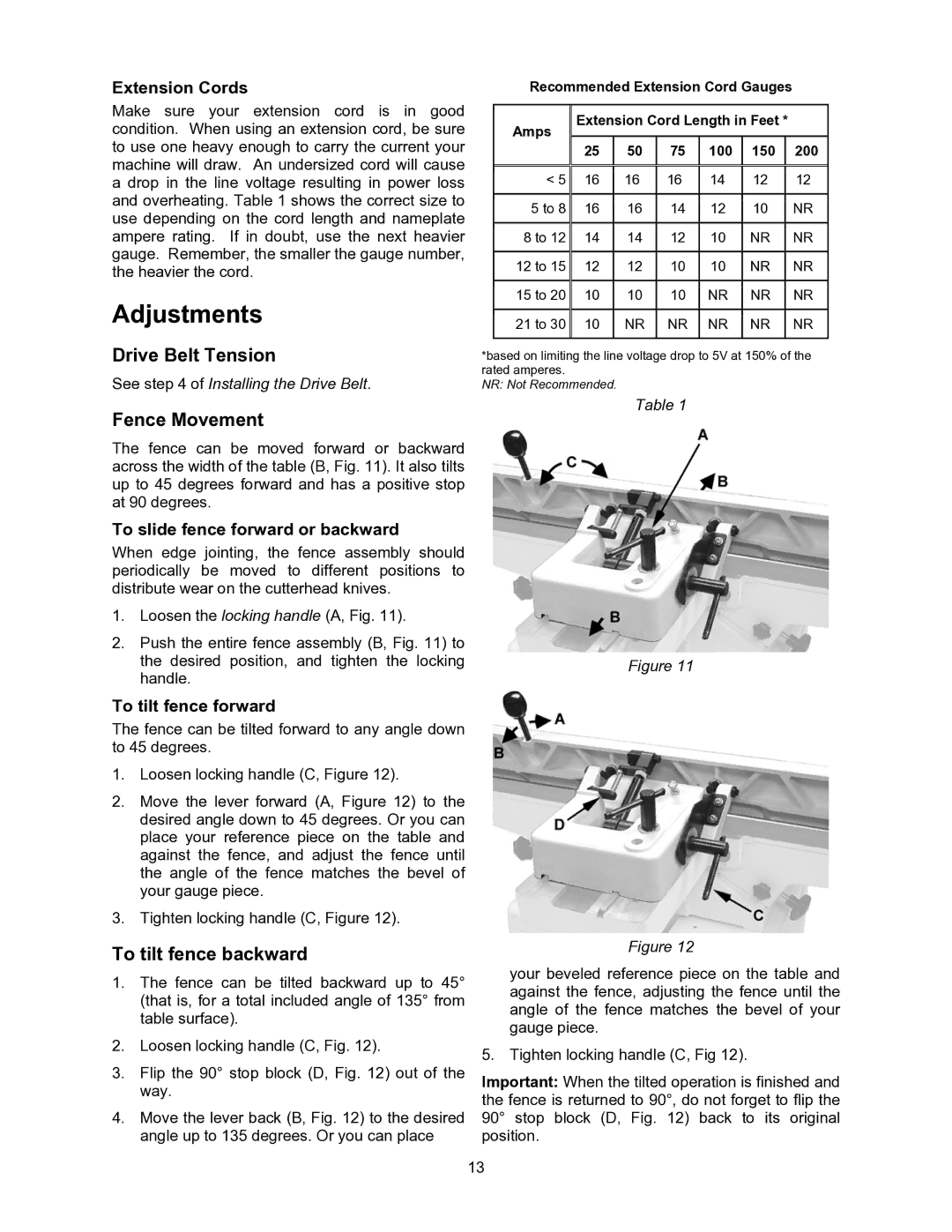
Extension Cords
Make sure your extension cord is in good condition. When using an extension cord, be sure to use one heavy enough to carry the current your machine will draw. An undersized cord will cause a drop in the line voltage resulting in power loss and overheating. Table 1 shows the correct size to use depending on the cord length and nameplate ampere rating. If in doubt, use the next heavier gauge. Remember, the smaller the gauge number, the heavier the cord.
Adjustments
Drive Belt Tension
See step 4 of Installing the Drive Belt.
Fence Movement
The fence can be moved forward or backward across the width of the table (B, Fig. 11). It also tilts up to 45 degrees forward and has a positive stop at 90 degrees.
To slide fence forward or backward
When edge jointing, the fence assembly should periodically be moved to different positions to distribute wear on the cutterhead knives.
1.Loosen the locking handle (A, Fig. 11).
2.Push the entire fence assembly (B, Fig. 11) to the desired position, and tighten the locking handle.
Recommended Extension Cord Gauges
Amps | Extension Cord Length in Feet * |
| |||||
|
|
|
|
|
|
| |
| 25 | 50 | 75 | 100 | 150 |
| 200 |
|
|
|
|
|
|
|
|
< 5 | 16 | 16 | 16 | 14 | 12 |
| 12 |
|
|
|
|
|
|
|
|
5 to 8 | 16 | 16 | 14 | 12 | 10 |
| NR |
|
|
|
|
|
|
|
|
8 to 12 | 14 | 14 | 12 | 10 | NR |
| NR |
|
|
|
|
|
|
|
|
12 to 15 | 12 | 12 | 10 | 10 | NR |
| NR |
|
|
|
|
|
|
|
|
15 to 20 | 10 | 10 | 10 | NR | NR |
| NR |
|
|
|
|
|
|
|
|
21 to 30 | 10 | NR | NR | NR | NR |
| NR |
|
|
|
|
|
|
|
|
*based on limiting the line voltage drop to 5V at 150% of the rated amperes.
NR: Not Recommended.
Table 1
Figure 11
To tilt fence forward
The fence can be tilted forward to any angle down to 45 degrees.
1.Loosen locking handle (C, Figure 12).
2.Move the lever forward (A, Figure 12) to the desired angle down to 45 degrees. Or you can place your reference piece on the table and against the fence, and adjust the fence until the angle of the fence matches the bevel of your gauge piece.
3.Tighten locking handle (C, Figure 12).
To tilt fence backward
1.The fence can be tilted backward up to 45° (that is, for a total included angle of 135° from table surface).
2.Loosen locking handle (C, Fig. 12).
3.Flip the 90° stop block (D, Fig. 12) out of the way.
4.Move the lever back (B, Fig. 12) to the desired angle up to 135 degrees. Or you can place
Figure 12
your beveled reference piece on the table and against the fence, adjusting the fence until the angle of the fence matches the bevel of your gauge piece.
5. Tighten locking handle (C, Fig 12).
Important: When the tilted operation is finished and the fence is returned to 90°, do not forget to flip the 90° stop block (D, Fig. 12) back to its original position.
13
